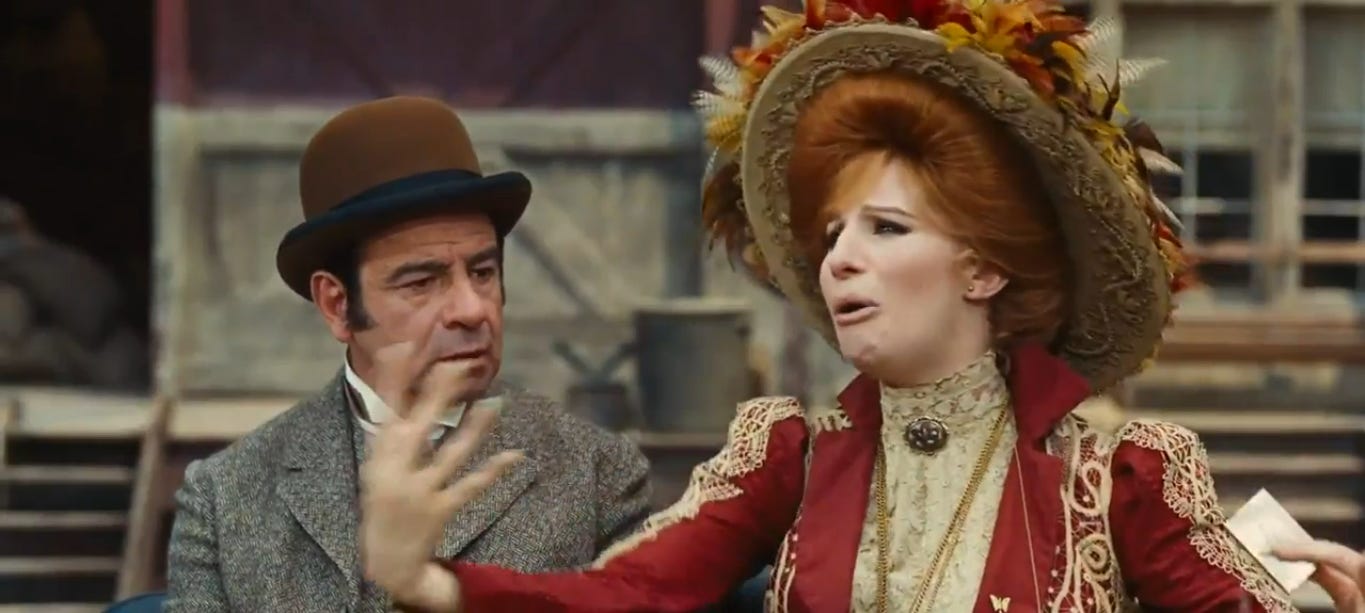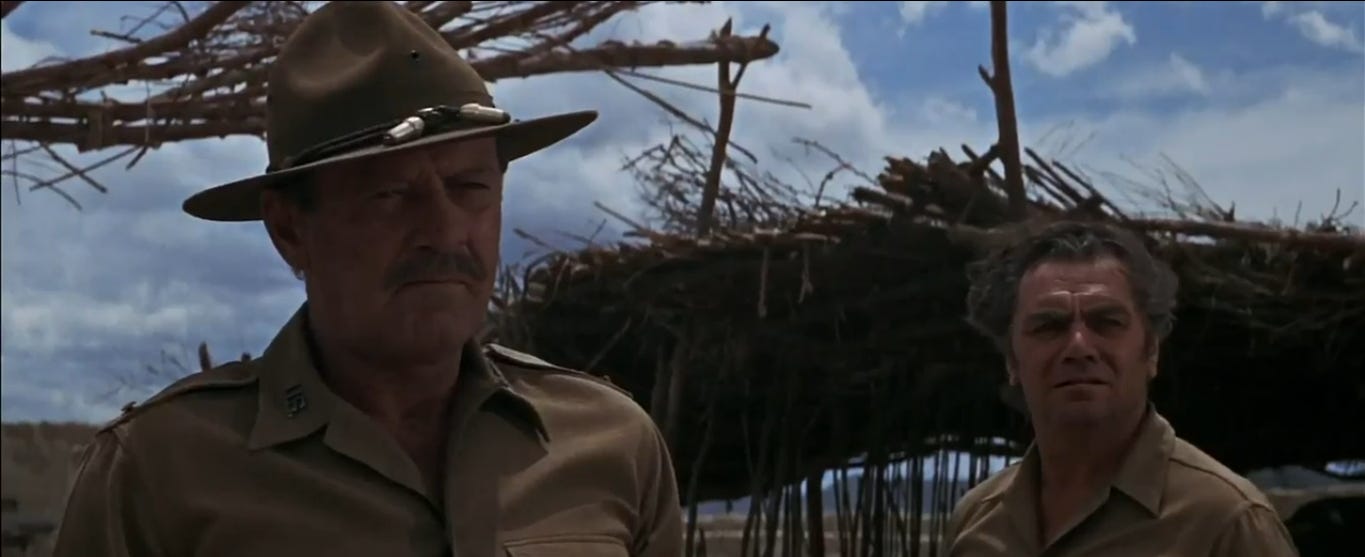What We Missed: 1969
Dolly, Butch, Captain America, and a Wild Bunch.
ICYMI: the five films nominated for Best Actor Oscars from 1969 were Midnight Cowboy (two nominations); True Grit; Goodbye, Mr. Chips; and Anne of the Thousand Days. The links provide the trivia write-ups on those films while this post discusses what else was happening in the movies that year.
1969 Best Picture winner: Midnight Cowboy. In 1968, Oliver! became the first and only G-rated film to win Best Picture. The next year, Midnight Cowboy became the first and only X-rated film to do so. It beat out Anne of the Thousand Days and the following three other films:
Hello, Dolly! If it had won, it would have given us back-to-back exclamation point Best Oscar winners. Considering only four exclamation point films have even been nominated for the top prize, that would have been pretty interesting. Or not, I guess.
Oh, you want facts about Hello, Dolly! that you can’t figure out from the title? Okay, here we go: it’s a musical based on “The Matchmaker,” a play by Thornton Wilder (which itself was a reworking of his previous play, “The Merchant of Yonkers”). On Broadway, Carol Channing played the titular Dolly, but Barbra Streisand got the call for the film. It co-starred Walter Matthau as the wealthy Horace Vandergelder and was directed by Gene Kelly. The title track was a number one hit for Louis Armstrong in 1964, and Armstrong cameoed in the film.While reading about the 1964 “Hello, Dolly!” musical, I added a handful of new names to my Anki slide deck: David Merrick, Gower Champion, and Jerry Herman. Those are some pretty deep cuts. You’re also welcome to note the 1967 all-Black stage version which starred Pearl Bailey and Cab Calloway.
Here’s the thing: is Hello, Dolly! even half as good as Funny Girl? No, it doesn’t even have Omar Sharif, c’mon now.Z: a lightly-fictionalized film about Greece’s military junta and the assassination of democratic politician Grigoris Lambrakis in 1963. This was only the second non-English language film nominated for Best Picture. (The first was the 1937 Jean Renoir film La Grande Illusion.)
The final film up for Best Picture was also the highest grossing…
1969 highest grossing film: Butch Cassidy and the Sundance Kid. Here’s what we wrote about the pair previously:
Butch Cassidy and his gang, the Wild Bunch, were train and bank robbers. That gang and many others hid out in the Wyoming mountains at a place called Hole-in-the-Wall. Cassidy and the Sundance Kid were pursued by the Pinkertons and eventually fled to Argentina, where they continued their lives of crime. They were likely killed in a shootout in Bolivia.
After a hundred of these posts, sometimes we can just point to old stuff. I gave the film a watch, though, so here’s some new content: it feels pointless. The film starts in media res (Cassidy and Sundance are already elite robbers) and the whole film is them being pursued until they are eventually killed. Yes, Paul Newman and Robert Redford are electric, but there’s no character journey—no one learns anything, grows, changes, nothing. Not interesting.
Best Actress Oscar race: the winner was Maggie Smith for The Prime of Miss Jean Brodie. She played an unorthodox teacher who tries to mold her students in her image. Unfortunately, that image is pro-fascist. [EDITOR’S NOTE: I removed a full paragraph about Paulo Freire’s “Pedagogy of the Oppressed” from here, you’re welcome.]
Geneviève Bujold scored a nomination for playing Anne Boleyn in Anne of the Thousand Days. The other three noms went to:
Jane Fonda for They Shoot Horses, Don't They? Directed by Sydney Pollack, this one is a period piece about a bunch of poor people suffering through a monthslong dance competition with a top prize of $1,500. The host sums it up: “[The viewers] just want to see a little misery out there so they can feel a little better, maybe.” This one’s still relevant today, what with the monetary rewards given for self-debasement on reality TV and social media.
Liza Minnelli for The Sterile Cuckoo. About a college relationship between an eccentric girl and a shy boy. We’ve seen both of Liza’s parents in this column and we’ll see a film of hers before long.
Jean Simmons for The Happy Ending. This one’s about a sad housewife.
Relitigating the Best Actor race: I enjoyed all five performances from 1969. John Wayne got his one and only Oscar win here, but I’d put O’Toole and Voight a tier above him, Hoffman, and Burton.
Quick Hits
Sigh, this first one isn’t a quick hit: we have to talk about Easy Rider. In my opinion, Easy Rider is the bad side of the New Hollywood coin: a sloppy film about unlikable characters. Sure, with the Vietnam War in full swing, I get why there’d be excitement to see representation of the hippie subculture on the big screen. But I struggle to see what it is the film wants to achieve, and its choppy editing, comically drugged-out performances, and whole “student film” vibe do not make this a pleasant watch.
Here’s what you’ve gotta know: Billy (Dennis Hopper) and Wyatt (called Captain America and played by Peter Fonda) are two bikers crossing the country with money made from a drug deal. They get into a bunch of shenanigans, then come to a Bonnie and Clyde-esque end on the highway. Hopper and Fonda wrote the movie (together with Terry Southern), Hopper directed, and they made it on a budget of $400,000. It’s a counterculture touchstone, but compare it to Midnight Cowboy: both are full of sex and drugs, but Midnight Cowboy’s character arc for Joe Buck is a story worth telling. What’s the point of watching the goons in Easy Rider?
Easy Rider’s not all bad: it’s got a nice supporting turn from Jack Nicholson, beautiful cinematography, and a rockin’ soundtrack. But it is mostly bad. (Though, if you want a counterpoint, here’s Quentin Tarantino gushing about the film.)
Okay, let’s get into regular ol’ quick hits:
Bob & Carol & Ted & Alice. Two couples get a little too open with each other.
Cactus Flower. A screwball comedy with Walter Matthau and Ingrid Bergman. It’s best known for Goldie Hawn’s Oscar-winning supporting performance.
Sam Peckinpah’s revisionist Western The Wild Bunch. Peckinpah’s known for his violent films, and yeah, The Wild Bunch is pretty bleak. Two of the wild bunchers are actors we’ve seen a few times: William Holden and Ernest Borgnine.
Two films known for their tiny rounded cars: The Italian Job (with the Mini Cooper chase) and The Love Bug (with Herbie, a sentient VW Beetle).
Quicker Hits: musicals Paint Your Wagon and Sweet Charity…Alice’s Restaurant, based on Arlo Guthrie’s very long song…the sci-fi film Marooned, about astronauts stuck in space (with life later imitating art)…Fellini’s Fellini Satyricon…On Her Majesty’s Secret Service, the one George Lazenby James Bond movie…Age of Consent, where James Mason basically plays Humbert Humbert again…Topaz, a Hitchcock film based on a Leon Uris novel…Goodbye, Columbus…
Trivia Questions
The quiz below serves as a refresher for some of the material covered in the four posts on 1969 films. The answers can be found in the footnotes.
What was Dustin Hoffman’s character’s name in Midnight Cowboy? His real name or derisive nickname are both acceptable answers.1
Whose cover of “Everybody’s Talkin’” refrains throughout Midnight Cowboy? He might be better known for the 1972 novelty “Coconut.”2
The Andy Warhol Museum is located in what U.S. city?3
The classic lineup of the Velvet Underground consisted of John Cale, Sterling Morrison, Moe Tucker, and what singer/songwriter/guitarist?4
JOHN WAYNE QUESTION: what’s the 1956 Wayne film where he searches for his abducted niece, played first by Lana Wood and then by Natalie Wood?5
What Pennsylvania congressman proposed the 1846 proviso that would ban slavery in the land acquired from the Mexican-American War?6
What “compromise,” orchestrated by Henry Clay and Stephen Douglas, let California enter the Union as a free state while strengthening the Fugitive Slave Act?7
What was the name for the bands of anti-slavery militants who clashed with pro-slavery groups during the period known as “Bleeding Kansas”?8
What co-star of Goodbye, Mr. Chips sang the #1 hit “Downtown”?9
Who wrote “Lost Horizon” (1933), a novel about a paradisaical lamasery called Shangri-La?10
Which gods are the months January, March, and April named after? (Three answers expected.)11
The eruption of Mt. Vesuvius in 79 AD destroyed Pompeii and which other town 10 miles to the northwest?12
Here come four Reformation questions: Who was the first person to translate the Bible into English? His followers were called “Lollards.”13
This Czech reformer was executed at the Council of Constance in 1415.14
This Dutch Humanist scholar authored “The Praise of Folly.”15
Martin Luther was called to this city on the Rhine in 1521 to recant his criticisms of the church.16
And we’ve finished another decade! As we did at the end of the 1950s, here’s a bar chart of our ratings for the 47 films we’ve watched from the 1960s:
Some elite films (Elmer Gantry, To Kill a Mockingbird, The Graduate) and lots of good-to-great ones. We didn’t have to endure any junk like The Robe or Viva Zapata! this decade—I couldn’t find a single movie to roast with a 1 or a 2, and only This Sporting Life ended up with a 3. Let’s hope this upward trend continues as we get into the third decade of this newsletter.
Rico Rizzo, called “Ratso.”
Harry Nilsson.
Pittsburgh.
Lou Reed.
The Searchers.
David Wilmot (of the Wilmot Proviso).
Compromise of 1850 (if you said Missouri Compromise, that was 30 years earlier).
Jayhawkers (the University of Kansas’ sports teams are called the Jayhawks).
Petula Clark.
James Hilton (he also wrote “Goodbye, Mr. Chips”).
Janus, Mars, and Aphrodite. (Also recall that May is named after Maia, a Pleiade, and June’s named after Juno.)
Herculaneum.
John Wycliffe.
Jan Hus.
Desiderius Erasmus.
Worms (the Diet of Worms).



